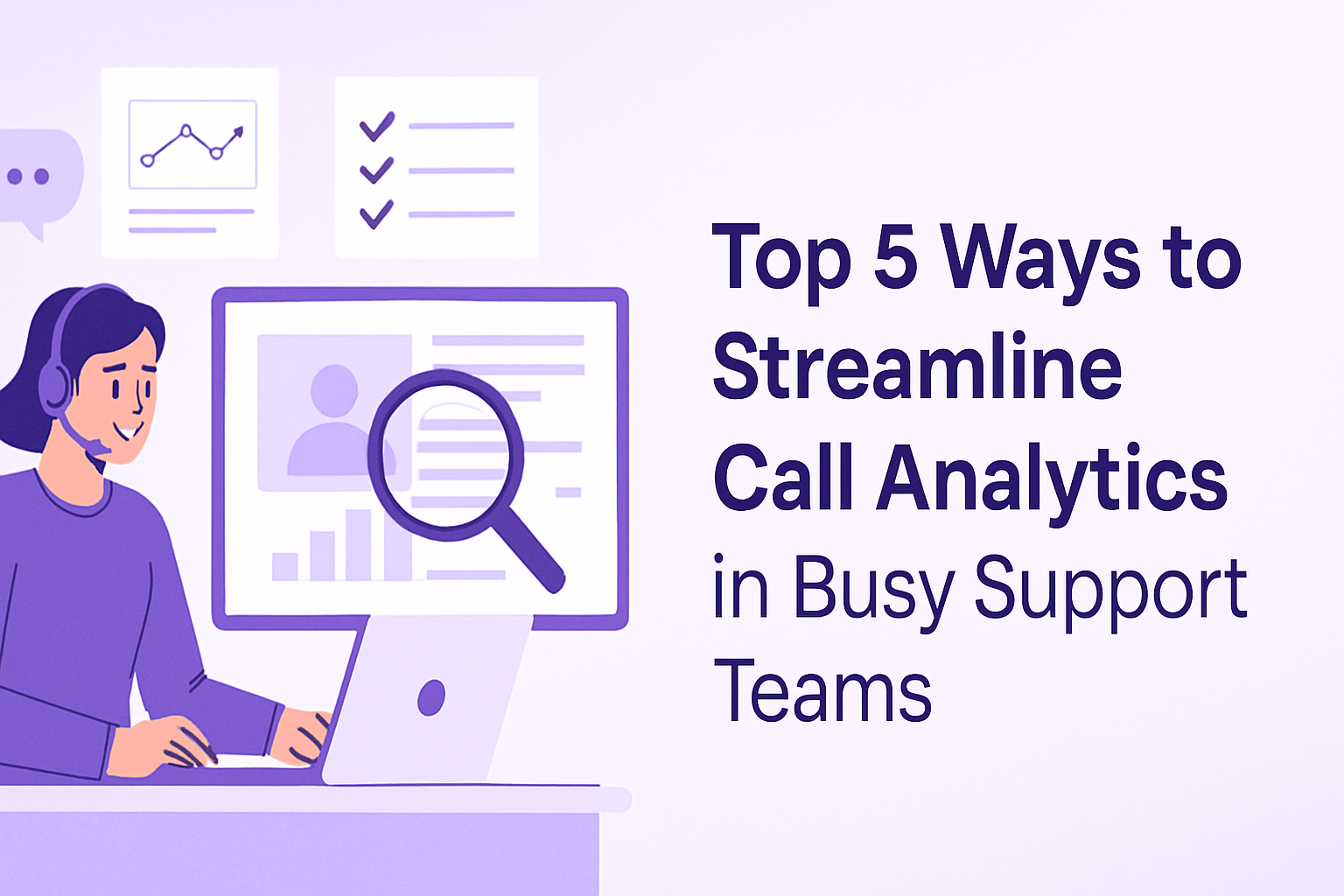How to Improve Sales Conversion Rates Using AI Call Analytics
-
Hello Insight
- 10 min read
How to Improve Sales Conversion Rates Using AI Call Analytics
In today's competitive marketplace, sales conversion rates are a critical measure of success for any B2B company. Leveraging AI call analytics can significantly enhance these rates by transforming how organizations understand customer interactions. This guide delves into the benefits of AI call analytics and how organizations can implement these solutions to drive revenue growth.
The Role of AI Call Analytics in Modern Sales
AI call analytics has become essential for modern organizations looking to optimize their sales processes. By utilizing advanced technologies to analyze customer conversations, businesses can uncover valuable insights that empower sales teams to make informed decisions.
This approach shifts organizations from reactive to proactive strategies. Instead of merely responding to customer inquiries, teams can anticipate needs and address concerns, fostering a more engaging customer experience. The alignment created across sales, marketing, and customer service teams ensures a cohesive strategy that drives conversions.
To effectively implement AI call analytics, organizations need a robust data infrastructure that can integrate with existing tools and platforms.
What is AI Call Analytics?
AI call analytics refers to the use of artificial intelligence to analyze voice interactions during sales calls. This innovative technology captures and processes various data points, including sentiment, keywords, and customer intent, providing a comprehensive overview of customer interactions.
Unlike traditional methods that often involve manual review of call recordings, AI call analytics enables organizations to look ahead by identifying trends and patterns in customer behavior. This forward-thinking approach enhances the ability to make data-driven decisions.
Core Capabilities:
- Sentiment Analysis: Understand emotional cues in customer conversations, leading to better engagement strategies.
- Keyword Tracking: Identify critical phrases that resonate with customers, enabling tailored marketing efforts.
- Performance Metrics: Evaluate sales team effectiveness through detailed scoring of calls, leading to focused training and development.
- Automated Insights: Generate actionable recommendations based on call data, streamlining the decision-making process.
Strategic Value: This technology empowers organizations to make proactive decisions that align with customer needs and market demands.
Why Are Consultants and Insight-Seeking Personnel Investing in AI Call Analytics?
Context Setting: Organizations are moving from outdated methodologies that rely on basic metrics to advanced AI-driven approaches that yield deeper insights into customer behavior.
Key Drivers:
- Increased Competition: With more options available to consumers, businesses must differentiate themselves through exceptional customer experiences.
- Data Overload: Traditional methods of analyzing customer feedback often lead to inefficiencies; AI simplifies this process.
- Need for Personalization: Customers expect tailored interactions, and AI analytics provides the insights necessary to achieve this.
- Resource Optimization: AI allows for better allocation of resources, ensuring that sales teams focus on high-potential leads.
What Data Powers AI Call Analytics?
Foundation Statement: To build reliable AI call analytics models, a diverse range of data sources is critical.
Data Sources:
- Call Recordings: Captured interactions provide the primary data for analysis.
- CRM Systems: Integrating data from platforms like Salesforce enhances context.
- Feedback Channels: Insights from customer surveys and feedback forms enrich the understanding of customer sentiments.
- Sales Performance Metrics: Historical sales data helps identify what strategies have been effective.
Accuracy Benefit: A multi-modal approach enhances the accuracy of insights, leading to more effective sales strategies.
Key Components of an AI Call Analytics Stack
Stack Overview: The effectiveness of AI call analytics relies on several critical components that work together seamlessly.
Component Descriptions:
- Data Collection Module: Gathers call recordings and integrates with existing data sources.
- Processing Engine: Analyzes audio data for sentiment, keywords, and other important metrics.
- Insights Dashboard: Visualizes data in an easily digestible format for stakeholders to review.
- Feedback Loop: Continuously updates algorithms based on new data to improve accuracy and relevance.
Quality Emphasis: The effectiveness of AI call analytics is not just about having data; it’s about ensuring the quality and interpretability of that data.
Success Dependency: The effectiveness of AI call analytics relies heavily on the quality of input signals. Poor-quality data can lead to misleading insights.
How Does AI Call Analytics Work Step by Step?
Step 1: Data Collection
AI systems capture call recordings, integrating them with CRM data to provide context and content for analysis.
Step 2: Data Processing
The processing engine converts audio data into actionable insights, analyzing sentiment and identifying key phrases.
Step 3: Pattern Identification
During analysis, the system identifies patterns such as customer objections, preferences, and common pain points.
- Objection Handling: Recognizing recurring objections allows for targeted training.
- Customer Preferences: Insights into what customers are looking for can inform product development.
Step 4: Learning Process
The system uses historical data to refine its algorithms, enhancing predictive capabilities.
Step 5: Real-Time Processing
Insights are generated in real-time, allowing sales teams to adapt their strategies on the fly.
Step 6: Output and Recommendations
The system delivers actionable insights to sales teams, such as:
- Recommended Follow-up Actions: Suggesting next steps based on customer sentiment.
- Training Opportunities: Identifying areas where sales reps can improve based on performance data.
Where Can Consultants and Insight-Seeking Personnel Apply AI Call Analytics?
Enhanced Sales Training
- Method: Analyze calls for training opportunities.
- Result: Improved performance through targeted coaching.
Customer Insights
- Method: Use sentiment analysis to gauge customer satisfaction.
- Result: Tailored approaches that lead to higher conversion rates.
Lead Qualification
- Method: Identify high-potential leads based on conversation quality.
- Result: Focused efforts on leads most likely to convert.
Performance Benchmarking
- Method: Compare performance metrics across teams and individuals.
- Result: Optimization of sales strategies based on data-driven insights.
What Tools Can You Use for AI Call Analytics?
When selecting an AI call analytics platform, look for tools that integrate seamlessly with existing systems and provide robust analytics capabilities.
Comparison Table:
| Feature | Insight7 | Traditional Alternative |
|---|---|---|
| Sentiment Analysis | Yes | Limited |
| Real-Time Insights | Yes | No |
| Performance Scoring | Yes | Manual |
| Integration with CRMs | Yes | No |
| Automated Reporting | Yes | Manual |
Common Pitfalls in AI Call Analytics Implementation
Context Warning: Many organizations struggle with the implementation of AI call analytics due to a lack of strategy and alignment.
Major Pitfalls:
- Lack of Stakeholder Buy-In: Without buy-in from leadership, initiatives may falter.
- Data Quality Issues: Poor quality data can lead to ineffective decision-making.
- Integration Challenges: Difficulty in integrating with existing systems can limit effectiveness.
- Neglecting Training: Insufficient training for sales teams can hinder the adoption of insights.
Success Foundation: Avoiding these pitfalls requires a strategic approach that prioritizes stakeholder engagement and data quality.
How Do You Get Started with Insight7?
Step 1: Integration
Ensure that your chosen platform can integrate with existing tools like Salesforce and HubSpot.
Step 2: Data Synchronization
Set up data flows to capture call recordings and relevant customer data.
Step 3: Configuration
Customize the system according to your specific sales workflows and metrics.
Step 4: Training
Utilize historical call data to train the AI system for improved insight accuracy.
Step 5: Customization
Tailor the dashboards and reporting tools to meet the needs of different stakeholders.
Step 6: Ongoing Optimization
Establish a routine for reviewing insights and refining strategies based on performance data.
What Is The Best AI Call Analytics Setup?
ROI Optimization: To maximize return on investment, organizations must implement best practices that ensure effective use of AI call analytics.
Best Practices:
- Diverse Data Inputs: Ensure a variety of data sources for comprehensive analysis.
- Stakeholder Engagement: Involve key stakeholders in the setup process.
- Regular Review: Continuously monitor and review performance metrics.
- Automation Integration: Utilize automation to streamline processes.
Building an AI Call Analytics Strategy That Scales
Scaling an AI call analytics strategy requires collaboration across teams. Defining a clear strategy that aligns with business objectives ensures that the insights generated lead to actionable outcomes.
Diverse data types feed into better models, allowing organizations to continually refine their approaches. Ongoing evaluation and adaptation are essential to maintaining a competitive edge.
AI Call Analytics Benchmarks and Success Metrics
Evaluation Framework: Clear benchmarks are essential for measuring the impact of AI call analytics.
Core Metrics:
- Conversion Rates (measuring the percentage of leads that convert).
- Customer Satisfaction Scores (gauging customer happiness).
- Agent Performance Metrics (evaluating individual and team effectiveness).
- Call Resolution Rates (tracking the effectiveness of interactions).
- Training Improvement Metrics (assessing the impact of training programs).
Universal Principle: The value derived from AI call analytics comes from improved decision-making and actionable insights.
Frequently Asked Questions
Q: What is AI call analytics?
A: AI call analytics involves using AI technology to analyze customer interactions during calls, providing insights into sentiment, performance, and customer behavior.
Q: How does it differ from traditional methods?
A: Traditional methods often rely on manual reviews, while AI call analytics automates the process, providing real-time insights and reducing human error.
Q: What platforms are compatible?
A: Many platforms, including CRM systems like Salesforce and customer feedback tools, can integrate with AI call analytics solutions.
Q: What data is required?
A: Ideal data sources include call recordings, CRM data, and customer feedback.
Q: How long does implementation take?
A: Implementation speed varies, but organizations can typically see value within weeks of setup.
Q: What security measures are in place?
A: Platforms often comply with industry standards, ensuring data security and privacy.






